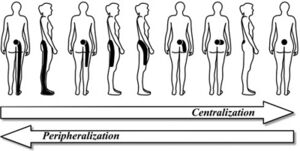Directional Preference
Definition[edit | edit source]
The clinical phenomenon where using a specific direction of repeated movement or a sustained positions results in an improvement in either symptoms or mechanical presentation. It was originally hypothesized to occur due to a specific movement causing a reductive force on displaced disc material[1], however, this may not always be the case due to people experiencing a directional preference without disc displacement.
It has commonly associated with Mechanical Diagnosis and Therapy (the McKenzie Approach) for the treatment of derangement classifications of the spine.
Directional Preference vs. Centralization[edit | edit source]
Often, it is believed that the phenomenon of directional preference and centralization are the same. However, both are separate events that can occur. Centralization is the movement of distal symptoms proximally toward the spine through mechanical loading. Each even can occur separately at times. Some can have a directional preference without experiencing centralization, however, a patient cannot experience centralization without a directional preference.
Prevalence and Outcome[edit | edit source]
In patients with neck and back pain, it has been found that a directional preference was present in 70%[2]. Another study[3], found that in patients with low back pain, a directional preference was found in 60% of the participants.
The rates of finding a directional preference do decrease with both age and chronicity of the symptoms in patients with low back pain [3]. Patients who show a directional preference with centralization at their intake visit have better functional status and less pain compared to people who's symptoms neither centralized nor a directional preference was found.
Directional Preference in the Extremities[edit | edit source]
Directional preference is widely associated with the treatment of lumbar and neck pain. Directional preference has been found in the extremities as well when treating pain. One case series[4] found that patients who presented with shoulder pain were treated with repeated movements after determining their directional preference. Another study[5] found that after determining a directional preference, the patient was able to return to sport with no limitations.
References[edit | edit source]
- ↑ Wetzel FT, Donelson R. The role of repeated end-range/pain response assessment in the management of symptomatic lumbar discs. Spine J. 2003 Mar-Apr;3(2):146-54. doi: 10.1016/s1529-9430(02)00565-x. PMID: 14589229. https://pubmed.ncbi.nlm.nih.gov/14589229/
- ↑ MAY, Stephen and AINA, A (2012). A centralization and directional preference : a systematic review. Manual Therapy, 17 (6), 497-506. http://shura.shu.ac.uk/6975/1/May_-_Centralization.pdf
- ↑ 3.0 3.1 Werneke MW, Hart DL, Cutrone G, Oliver D, McGill T, Weinberg J, Grigsby D, Oswald W, Ward J. Association between directional preference and centralization in patients with low back pain. J Orthop Sports Phys Ther. 2011 Jan;41(1):22-31. doi: 10.2519/jospt.2011.3415. Epub 2010 Oct 22. PMID: 20972343.https://www.jospt.org/doi/pdfplus/10.2519/jospt.2011.3415
- ↑ Aytona, M. C., & Dudley, K. (2013). Rapid resolution of chronic shoulder pain classified as derangement using the McKenzie method: a case series. The Journal of manual & manipulative therapy, 21(4), 207–212. https://www.ncbi.nlm.nih.gov/pmc/articles/PMC3822320/?utm_content=bufferb0cc3&utm_medium=social&utm_source=linkedin.com&utm_campaign=buffer
- ↑ Lynch, G., & May, S. (2013). Directional preference at the knee: a case report using mechanical diagnosis and therapy. The Journal of manual & manipulative therapy, 21(1), 60–66. https://www.ncbi.nlm.nih.gov/pmc/articles/PMC3578196/?utm_content=bufferd9861&utm_medium=social&utm_source=facebook.com&utm_campaign=buffer







